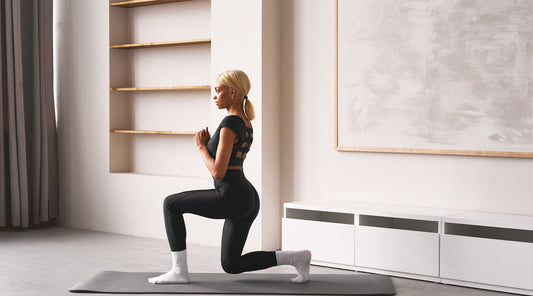Poor posture has become something of an epidemic. The way you sit, stand, sleep, and walk can have major impacts on both your physical and mental health. Poor posture can create spinal and balance issues, headaches, digestive problems, breathing difficulties, and reduced focus and productivity. It can even impact the way you enjoy your food.
Posture correctors are meant to help you sit up straight, but not all are created equal. The most effective posture correctors slowly and gently train your muscles to maintain better posture throughout the day. They can help:
- Alleviate back aches and pains
- Reduce stress on your joints and bones
- Reduce risk of injury
- Increase mobility
- Make breathing easier
- Improve your digestion
- Boost your mood and confidence
Below, we dive deep into the world of posture correctors, including what to look for when purchasing one, common mistakes to avoid, and how to use a posture corrector to bring out the best version of yourself.
Understanding Posture Correctors
Back pain is not just a burden, it’s a major concern for many adults—it’s even one of the costliest medical conditions in the U.S. (1). If you’re feeling discomfort and pain in your neck or back, it’s likely due to your posture. The effects of everyday activities like looking down at your phone or computer, sitting in an uncomfortable chair, slouching on the sofa, or sleeping on an unsupportive mattress will start to sneak up on you.
Using a posture corrector can have an immediate impact on your posture, but it also works to train your spinal and shoulder muscle memory to keep an upright position. Over time, the action of gently pulling your shoulders back and keeping your head neutral should start to come naturally.
In general, posture correctors work to:
- Gently pull your shoulders back to open your chest, stabilize your spine, and prevent slouching
- Relieve back and neck pain due to poor posture
- Train your muscles to sit and stand up straight
- Teach you to maintain good posture in all situations
*Note that if you have scoliosis, serious back issues, or any severe injuries, you should seek a medical professional’s advice before using a posture corrector or starting any exercise regimen.
Do you need a posture corrector?
A posture corrector may be beneficial if you:
- Work long hours, either at a desk or on your feet
- Experience neck, back, or shoulder pain
- Suffer from headaches (which may be triggered by tension in your neck, shoulders, or upper back)
- Struggle to maintain good form while exercising
- Have digestive issues (which an worsen from poor posture)
If you’re experiencing any of the above, you may want to try using a posture corrector, which can help activate the proper muscles and relieve tension in your back, neck, and shoulders.
Choosing the Right Posture Corrector
There are various posture correctors on the market, from bulky braces to high-tech gadgets to functional apparel like the Etalon posture correcting bra. You can even download an app to remind you to sit up straight, but that won’t have a direct impact on your posture.
The right posture corrector should, first and foremost, address the root cause of your pain or discomfort. Here are some points to consider when choosing a posture corrector:
Where are your weak areas?
Different posture correctors focus on different parts of your body. Most target your shoulders, cervicothoracic junction (where the neck meets the upper back), and lumbar spine (the lower back). If you notice an arched back, try a corrector with lumbar support. For hunched shoulders, try one that keeps your shoulders down and back. Take the Etalon's posture quiz to find out which posture correcting bra may suit your needs.
You may not be able to detect your weak areas immediately. Keep in mind that one posture problem (like a forward head) can cause another posture problem (like an arched back). Also, the pain in your neck could be due to an issue in your lower back. If you’re unsure where your weak areas are, consult a doctor to discuss what type of posture corrector may be best for you.
Can you customize it?
We all have different bodies and different needs. A posture corrector that is adjustable will provide the best support. Posture correctors like Etalon feature customizable straps and allow you to change settings as your posture improves.
Is it comfortable, fashionable, and durable?
A posture corrector shouldn’t feel like a chore—or an embarrassment—to wear. Choose a posture corrector that is made with breathable, high-quality materials that won’t irritate your skin. And pick one that makes you look and feel good! The Etalon Posture Bra is made in the USA with eco-friendly materials and can be worn as a stylish bra or top.
How To Wear a Posture Corrector: Step-By-Step Guide
To properly wear a posture corrector you want to make sure it perfectly fits your body—it should not be too loose or too tight. A posture corrector with customizable levels allows you to adjust it to your shape, comfort level, and pace. Be sure to measure your rib cage and bust and follow the product’s sizing guide.
Here’s how to wear a posture corrector correctly, based on instructions for the Etalon Posture Bra:
- Put the bra on and make sure the straps are at the first (loosest) level. The sleeves should start at the end of your collarbones.
- Draw your shoulders back to feel a gentle pull from the bra.
- Wear your bra daily for as long as it’s comfortable (take it off while you’re sleeping!). Commit to wearing it daily for at least three weeks for optimal results.
- Once you start to feel comfortable at this level (we recommend at least three weeks to give your body time to develop muscle memory), move the strap up and repeat the above steps.
- Wash your posture corrector in cold water and hang dry.
When using a posture corrector for the first time, start slowly. Wear the back posture corrector for as little as 30 minutes at a time and build from there. Remember it shouldn’t feel uncomfortable!
Common Mistakes To Avoid
Posture correctors are not quick fixes. They are meant to slowly train your body to pull your shoulders back and find better alignment. Here are some common mistakes to avoid when learning how to wear a posture corrector.
- It’s too loose or too tight. Make sure the posture corrector fits properly. Measure yourself, follow the product’s size guide, and try to find one that is adjustable. A posture bra that is too loose won’t be effective, while one that is too tight may restrict your movement.
- You’re not wearing it enough. We recommend wearing your posture corrector daily to develop the habit of good posture. In general, it will take one week to adapt to the posture corrector, three weeks to form a new habit, and three months to stabilize that habit.
- You’re not incorporating postural exercises. A posture corrector is a helpful trainer, but to get the most out of it, you should also incorporate regular stretches and strengthening exercises—you only need about 10 minutes a day! Resistance bands are a great accompaniment to any posture corrector.
The Path To Good Posture
It’s important to know that using a posture corrector is not going to “fix” your posture. However, an effective one will help relieve neck and back pain, improve your body awareness, and train the correct muscles in your neck, shoulders, and back to maintain better posture without any extra help.
Wearing a posture corrector like the Etalon bra is even more beneficial when combined with specific stretches and strengthening exercises. Remember that the path to good posture will take time, effort, and patience, but it’s well worth the journey.
Source:
- Health Policy Institute: Chronic Back Pain. https://hpi.georgetown.edu/backpain/
- GoodRx Health: Do Posture Correctors Work? https://www.goodrx.com/well-being/movement-exercise/do-posture-correctors-work
FAQs
Can I wear a posture corrector all day?
Will wearing a posture corrector make my muscles weaker?
Can I exercise while wearing a posture corrector?
How long will it take to see results from using a posture corrector?
Can I sleep in a posture corrector?
Trending
Try Etalon posture improvement products









